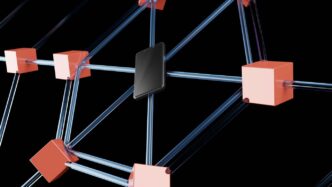It feels like every day there’s a news story about some kind of digital break-in. You hear about big companies losing data, or maybe even someone you know having their online accounts messed with. It makes you wonder, is a possible cyber attack today a real threat for regular people and businesses? The short answer is yes, and it’s getting more complicated. We’re not just talking about simple computer viruses anymore; the ways attackers try to get in are changing fast. Let’s break down what’s happening and what you should know.
Key Takeaways
- The financial damage from cybercrime is massive and growing, already costing trillions and expected to climb even higher, impacting global economic stability.
- Cyber threats are constantly evolving, from common malware and social engineering tricks to more advanced, hidden attacks like ransomware and nation-state actions.
- New technologies like AI and deepfakes are making attacks more sophisticated and harder to spot, blurring the lines between real and fake information.
- Our connected world, including IoT devices, supply chains, and cloud services, has many weak spots that attackers can exploit.
- The human element remains a major factor, with social engineering tactics like fake emails and calls continuing to trick people into giving up sensitive information.
The Escalating Financial Impact Of Cybercrime
It feels like every other day we hear about another massive cyberattack, and honestly, it’s getting a bit much. But beyond the headlines, there’s a serious financial side to all this that we really need to pay attention to. The numbers are pretty eye-opening, and they show just how much this is costing us, both as individuals and as a society.
Let’s talk numbers for a second. It’s not just a few million here and there anymore. We’re talking about trillions. Estimates from places like Statista show that the global cost of cybercrime is expected to jump from around $9.22 trillion in 2024 to a mind-boggling $13.82 trillion by 2028. That’s a huge jump, and it means cybercrime is becoming a bigger financial drain than many other global problems combined. It’s a real threat to how businesses operate and invest, and it can even mess with the stability of our economies. We’re seeing more and more organizations needing to spend big on cybersecurity defenses just to keep up.
Think about it: the damage from cyberattacks is projected to dwarf the yearly costs of natural disasters. It’s also becoming a bigger earner for criminals than the illegal drug trade. That’s a wild thought, isn’t it? This isn’t just about stolen credit card numbers anymore. It’s about entire systems being shut down, huge ransoms being demanded, and businesses losing massive amounts of money. The FBI reported billions in losses just in 2024, and that’s likely just the tip of the iceberg.
When cybercrime gets this big, it doesn’t just affect the companies that get hit directly. It has ripple effects. Businesses might hold back on investing in new ideas or expanding because they’re worried about the cost of a potential breach. This can slow down innovation and make it harder for the economy to grow. Plus, when critical services get disrupted, it affects everyone. We’re seeing a few key areas where this is particularly worrying:
- Disruption: Attacks that take down internet services or critical infrastructure can halt trade and daily life.
- Distortion: The spread of fake information, often amplified by bots, makes it hard to trust what we see online, which can have real-world consequences.
- Deterioration: As technology gets more advanced, it becomes harder for organizations to keep control of their own data and systems, especially with conflicting rules about national security and privacy.
It’s a complex problem, and the financial stakes are incredibly high.
Evolving Landscape Of Cyber Threats
The digital world is always changing, and unfortunately, so are the ways bad actors try to mess with it. It feels like every week there’s some new trick or technique making its way around. We’re not just talking about simple viruses anymore; the threats are getting way more complex and, frankly, a lot scarier.
Malware And Its Pervasive Forms
Malware, short for malicious software, is still a huge problem. Think of it as digital sickness. It comes in all sorts of flavors: viruses that spread like a cold, ransomware that locks up your important files until you pay, and spyware that secretly watches everything you do. These programs can really mess up how things work, steal your personal info, or just break your computer.
- Viruses: These attach themselves to legitimate programs and spread when those programs are run.
- Worms: Similar to viruses, but they can spread on their own without needing to attach to another file.
- Trojans: These disguise themselves as useful software but contain hidden malicious functions.
- Spyware: Secretly collects information about your activities and sends it to someone else.
- Ransomware: Encrypts your data and demands payment for its release.
Social Engineering Exploits Human Interaction
This is where attackers play on our natural tendencies. Instead of hacking into a system directly, they trick people into giving up sensitive information or access. It’s like a con artist, but online. Phishing emails are the classic example, but it’s gotten more sophisticated. They might send you a fake email that looks exactly like it’s from your boss, asking you to wire money. Or they might call you, pretending to be from your bank, trying to get your account details. These attacks work because they prey on trust and urgency.
- Spear Phishing: Highly personalized emails targeting specific individuals, often appearing to be from someone they know.
- Vishing (Voice Phishing): Using phone calls to trick people into revealing information.
- Smishing (SMS Phishing): Using text messages to lure victims into clicking malicious links or providing data.
Advanced Persistent Threats Target Specific Entities
These are the long-game attacks. Think of a spy movie. Attackers, often backed by governments or large criminal groups, get into a network and stay there, hidden, for a long time. They aren’t just looking to cause chaos; they want to steal specific data, spy on operations, or set up for a future, bigger attack. Because they’re so stealthy and patient, they can be incredibly hard to find until it’s too late.
Ransomware Demands Significant Payouts
Ransomware has become a massive headache. It’s not just about locking your files; these attacks can cripple entire businesses, hospitals, and even city services. The attackers encrypt everything and then demand a hefty sum, often in cryptocurrency, to give you the key to unlock it. Sometimes, they’ll also steal your data and threaten to release it publicly if you don’t pay. The costs associated with these attacks, from the ransom itself to the downtime and recovery efforts, can be astronomical.
AI And Deepfake Technology: New Frontiers In Cyber Attacks
Artificial intelligence and deepfake technology are really changing the game when it comes to cyber attacks. It’s not just about more complex code anymore; it’s about fooling people and systems in ways we haven’t seen before. These tools are getting really good, and that’s making them a big problem for cybersecurity.
AI-Powered Attacks Increase Sophistication
Think about how AI can learn and adapt. Cybercriminals are using this to make their attacks way smarter. They can find weak spots in systems faster, create emails that look super real – like they’re from your boss or a known company – and even change their tactics on the fly if they hit a security measure. It’s like they have a digital chameleon. This means our old security systems might not be enough. We need to start thinking about how to use AI ourselves to fight these AI-driven threats.
Deepfakes Mimic Reality With AI
Deepfakes are pretty wild. They use AI to make fake videos, audio, or images that look and sound like real people. It’s getting really hard to tell what’s real and what’s not. Imagine getting a video call from your CEO asking for an urgent wire transfer, but it’s actually a deepfake. That’s the kind of thing we’re talking about. The number of these fake media files is growing fast. It’s estimated that by 2025, there could be around 8 million deepfakes shared online. That’s a huge jump from just a few years ago.
Exponential Growth Of Deepfake Technology
The reason deepfakes are spreading so quickly is that the tools to make them are becoming more available, and there’s a lot of data online (like photos and videos of people) that the AI can use to learn. This makes it easier for anyone, not just expert hackers, to create convincing fakes. It’s a serious challenge because it can be used for all sorts of bad things, from spreading misinformation to outright fraud. We’re seeing fake images of celebrities endorsing political candidates, which can really sway public opinion. It’s a whole new level of deception we have to deal with.
Digital Infrastructure Vulnerabilities
Our digital world is built on layers of interconnected systems, and like any complex structure, it has weak spots. As we rely more and more on technology, these vulnerabilities become bigger targets for folks looking to cause trouble. We’re talking about the very foundations of our online lives – things like the Internet of Things, the complex web of our supply chains, and the vastness of cloud computing.
Think about all the gadgets connected to the internet these days. It’s not just your phone or computer anymore; it’s your smart fridge, your thermostat, even industrial sensors. The problem is, many of these devices weren’t built with security as a top priority. They often have weak passwords, outdated software, or just plain insecure ways of communicating. This makes them easy pickings. By 2030, the number of these connected devices is expected to more than double, reaching over 32 billion. That’s a massive attack surface. Hackers can take over these devices, often without us even knowing, and use them to launch bigger attacks, like overwhelming websites with traffic.
- Weak Passwords: Many IoT devices ship with default passwords that users never change.
- Outdated Software: Manufacturers don’t always update the software on these devices, leaving known security holes open.
- Insecure Networks: Devices might connect to Wi-Fi networks without proper encryption.
Imagine a company that makes software. They use code from other companies, and those companies use code from others, and so on. This is a supply chain. A supply chain attack is when hackers find a weak link in this chain – maybe a small software provider that doesn’t have great security – and use it to get into bigger, more secure targets. It’s like finding a back door into a fortress by bribing a single guard. These attacks have become incredibly common, affecting millions of people and costing businesses a lot of money. It really makes you wonder who you can trust.
| Year | Increase in Organizations Affected | Average Annual Loss Per Organization |
|---|---|---|
| 2018-2024 | 2,600% | $82 million |
Most businesses today use cloud services to store data and run applications. It’s convenient and often cheaper than managing their own servers. But this convenience comes with its own set of risks. The biggest issues usually come down to simple mistakes, like misconfiguring the cloud settings or not controlling who has access to what. A poorly secured cloud storage bucket can expose sensitive company data to anyone who finds it. This has led to major data leaks for even large companies. Keeping cloud environments safe means constant checking of settings and making sure only the right people can get to the data.
Sophisticated Attack Vectors

Cyber attackers are constantly finding new ways to get into systems, and some of these methods are pretty advanced. It’s not just about random attempts anymore; these are often carefully planned operations. We’re seeing a rise in attacks that are designed to be hard to spot and can cause a lot of damage before anyone even realizes what’s happening. These sophisticated vectors are a major reason why staying vigilant is so important in today’s digital world.
Distributed Denial of Service Attacks Intensify
Think of a DDoS attack like a massive traffic jam deliberately caused on a highway. Attackers flood a website or online service with so much fake traffic that legitimate users can’t get through. This makes the service unusable. In 2024, we saw a big jump in attacks that use multiple methods at once, making them harder to block. Some attacks even spread traffic across many different internet addresses, really challenging the people trying to defend the systems. It’s like trying to plug holes in a dam while the water pressure keeps increasing from all sides.
Man-in-the-Middle Attacks Intercept Communications
These attacks are like having someone secretly listen in on and even change your conversations without you knowing. An attacker positions themselves between two communicating parties, like your computer and a website, and intercepts the data. They can read it, change it, or even inject their own information. This is especially worrying with online banking or shopping. While encryption helps, attackers are getting smarter, sometimes exploiting weaknesses in the security protocols themselves. There have even been cases where attackers used fake Wi-Fi hotspots to intercept login details for things like car accounts, allowing them to gain unauthorized access. It’s a sneaky way to steal information or cause trouble.
Injection Attacks Target Web Applications
Injection attacks happen when an attacker tricks a web application into running unintended commands. They do this by sending specially crafted data that the application then processes incorrectly. A common type is SQL injection, where attackers insert malicious code into database queries. This can let them steal sensitive information, change data, or even take control of the database. Another type is Cross-Site Scripting (XSS), where attackers inject harmful scripts into web pages that other users will visit. This can lead to stolen login details or personal information. Developers need to be very careful about how they handle data coming from users to prevent these kinds of breaches.
Human Element In Cyber Security
You know, it’s easy to think about firewalls and encryption and all that techy stuff when we talk about cyber attacks. But honestly, a lot of the time, the weakest link isn’t a piece of software; it’s us. People. We’re the ones who click on suspicious links, we’re the ones who might accidentally give away company secrets because someone sounded really official on the phone. It’s a bit scary when you think about it, because no matter how fancy our digital defenses are, if someone can just trick a person, they can get right in.
Social Engineering Tactics Evolve
This isn’t new, but it’s getting way more sophisticated. Attackers are really good at playing on our emotions. They might create a sense of urgency, making you feel like you have to click that link or reply to that email right now, or maybe they’ll play on your curiosity. Sometimes they just pretend to be someone they’re not – like a boss asking for a favor, or tech support needing your password to ‘fix’ something. It’s all about making you do something you normally wouldn’t.
Business Email Compromise Schemes
This one’s a biggie, especially for businesses. Imagine getting an email that looks exactly like it’s from your CEO, asking you to wire money for a super important, top-secret deal. Or maybe it’s from HR, asking you to update your payroll information. These emails are crafted so well now, often after the attacker has done a ton of research on the company, that it’s really hard to tell they’re fake. By the time anyone realizes it was a scam, the money’s gone, or the sensitive data has been stolen. It’s a huge financial headache.
Baiting and Pretexting Tactics
Baiting is like leaving a tempting lure. Think about finding a USB drive labeled ‘Confidential Salaries’ just lying around. You’d be curious, right? Plug it in, and boom – malware. Pretexting is a bit like acting. The attacker invents a whole story, a ‘pretext,’ to get you to spill information. They might call pretending to be from a bank, a government agency, or even a survey company, and they’ll ask you questions that seem harmless but are actually designed to collect sensitive details. It’s all about building a false sense of trust to get what they want.
Nation-State And Insider Threats
When we talk about cyber threats, it’s easy to focus on hackers from far away or shadowy groups. But sometimes, the biggest risks come from closer to home. We’re talking about nation-states flexing their digital muscles and, perhaps even more concerning, people from within your own organization.
State-Sponsored Espionage and Sabotage
Governments around the world are increasingly using cyber tools for their own goals. Think of it as digital spying or even digital sabotage. These aren’t just random attacks; they’re often planned and funded by a country’s leadership. The aim can be to steal secrets from other countries or companies, disrupt critical services like power grids or financial systems, or even to influence elections. These attacks are usually pretty sophisticated because they have a lot of resources behind them. They might use custom-made malware or exploit very specific weaknesses that only a well-funded group could find. It’s a whole new level of digital conflict.
Insider Threats Bypass Traditional Defenses
Now, let’s talk about the people on the inside. An insider threat isn’t necessarily someone who’s a bad person. It could be an employee who accidentally clicks on a bad link, or someone who gets frustrated with the company and decides to cause trouble. But it can also be someone deliberately trying to steal data or cause damage. The tricky part is that these individuals often already have legitimate access to systems. They know the company’s routines, its weak spots, and how things work. This makes them incredibly hard to detect because their actions might look normal at first glance. Traditional security measures often focus on external threats, making insider risks a blind spot.
Here’s a quick look at how insider threats can happen:
- Negligence: An employee accidentally exposes sensitive data through a mistake, like misconfiguring a cloud storage setting or losing a company laptop.
- Malice: A disgruntled employee intentionally steals data, sabotages systems, or sells company secrets.
- Compromise: An employee’s account is taken over by an external attacker, who then uses that access to cause harm.
Protecting Critical Infrastructure
When nation-states or insiders target critical infrastructure – things like power plants, water systems, or communication networks – the consequences can be devastating for everyone. These aren’t just digital problems; they can quickly become real-world emergencies. Protecting these systems requires a multi-layered approach. It means not only having strong technical defenses but also making sure the people who manage these systems are well-trained and trustworthy. Regular security checks, strict access controls, and constant monitoring are key. It’s a constant battle to stay ahead of those who want to exploit these vital services.
So, is a cyber attack a real threat today?
Yeah, it really is. We’ve seen how fast things are changing and how much money is involved – we’re talking trillions. It’s not just big companies or governments; anyone with an internet connection could be a target. From sneaky phishing emails to more complex attacks that mess with our systems, the bad guys are getting smarter. It’s kind of like a constant game of cat and mouse. The best thing we can do is stay aware, keep our software updated, and be a little suspicious of things that seem too good to be true or too urgent to ignore. Protecting ourselves online isn’t just an IT department’s job anymore; it’s something we all need to pay attention to.
Frequently Asked Questions
What are the most common ways hackers try to break into computers or accounts?
Hackers often use tricky methods like malware (bad software), phishing (fake emails or messages trying to trick you), and social engineering (playing on people’s trust). They might also use ransomware to lock your files and demand money, or try to overwhelm websites with too much traffic (DDoS attacks).
How can I keep my personal information safe from online dangers?
To protect yourself, always use strong, unique passwords for different accounts. Be very careful about clicking on links or opening attachments in emails or messages you weren’t expecting. Using antivirus software on your devices and thinking twice before sharing personal details online are also smart moves.
What are some recent examples of big cyber attacks?
Some significant cyber attacks that have happened include the SolarWinds attack, which affected many organizations through their software updates, and the Colonial Pipeline ransomware attack that disrupted fuel supplies. There have also been issues with Microsoft’s email systems that hackers exploited.
How do cyber attacks hurt businesses?
Cyber attacks can cost businesses a lot of money, damage their reputation, and stop their operations. They can also lead to legal trouble and fines if customer data is lost or stolen.
What should I do if I think my computer or account has been hacked?
If you suspect a cyber attack, tell your company’s IT department right away. If it’s a personal account, change your password immediately and any other passwords that might be the same. Make sure your devices are secure.
Where can I find reliable information about new cyber threats?
You can stay informed by checking official sources like the U.S. Cybersecurity and Infrastructure Security Agency (CISA). Subscribing to security news updates and following trusted cybersecurity experts on social media are also good ways to learn about the latest dangers.














